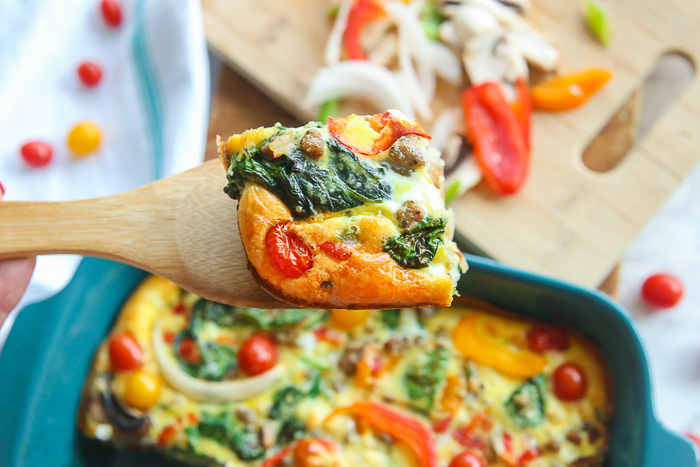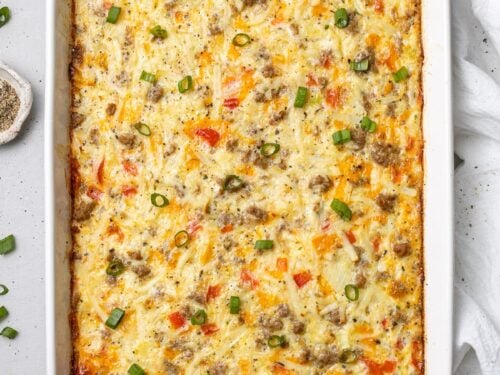Gluten-Free Breakfast Casseroles In the bustling world of modern mornings, where time is scarce and dietary needs are more diverse than ever, a gluten-free breakfast casserole stands out as a beacon of convenience, flavor, and nutrition. Whether you’re managing celiac disease, embracing a gluten-free lifestyle for gut health, or simply looking to mix up your brunch routine,https://tastetrove.net/ this versatile dish is a game-changer. Imagine waking up to the aroma of baked eggs mingled with savory sausage, crisp hash browns, and melted cheese—all without a trace of gluten to worry about.

Gluten-Free Breakfast Casseroles As we explore this topic, we’ll cover everything from the science behind going gluten-free to step-by-step recipes that even novice cooks can master. With over 3000 words of detailed content, this article is your one-stop resource.
Understanding the Basics: What Is a Gluten-Free Breakfast Casserole?
Gluten-Free Breakfast Casseroles is a one-pan wonder that combines eggs, proteins, vegetables, and starches into a baked dish that’s as nourishing as it is delicious. Unlike traditional casseroles that might rely on wheat-based breads or pastas for structure, gluten-free versions swap in naturally gluten-free alternatives like hash browns, quinoa, or certified gluten-free bread cubes. The result? A hearty, make-ahead meal that feeds a family or impresses brunch guests without triggering gluten sensitivities.
The history of breakfast casseroles traces back to American home cooking in the mid-20th century, when busy households sought efficient ways to feed crowds. The Gluten-Free Breakfast Casseroles twist emerged in the late 20th century alongside growing awareness of celiac disease and gluten intolerance. Today, with celiac affecting about 1 in 100 people worldwide, these casseroles are more relevant than ever. They embody simplicity: assemble the night before, refrigerate, and bake in the morning for a stress-free start to the day.
What sets a Gluten-Free Breakfast Casseroles apart is its adaptability. It’s not just about omission—it’s about elevation. Eggs provide the binding protein, while veggies add freshness and fiber. Meats like sausage or bacon infuse smokiness, and dairy (or dairy-free alternatives) brings creaminess. The “casserole” aspect refers to the layered, baked format, often in a 9×13-inch dish, yielding 8-12 servings.
For beginners, start small: Focus on balance. Gluten-Free Breakfast Casseroles Too much starch can make it heavy; too few eggs, and it won’t set. Pro tip: Always check labels for hidden gluten in processed meats or seasonings. This foundational understanding ensures your first attempt is a success, paving the way for creative experimentation.
Expanding on this, consider the cultural angle. In the U.S., these dishes shine at potlucks and holidays, but globally, similar concepts exist—like the Mexican chilaquiles casserole, adapted gluten-free with corn tortillas. Internally, if you’re exploring more gluten-free mains, check out our guide to gluten-free pasta alternatives.
The Health Benefits of Incorporating Gluten-Free Breakfast Casseroles into Your Diet
Gluten-Free Breakfast Casseroles Embracing a gluten-free breakfast isn’t just a trend; it’s a strategic choice for many. For those with celiac disease, an autoimmune disorder triggered by gluten that damages the small intestine, avoiding gluten is non-negotiable. A strict gluten-free diet heals the gut, improves nutrient absorption, and alleviates symptoms like bloating, fatigue, and diarrhea. Breakfast casseroles fit seamlessly here, offering a nutrient-dense start without wheat’s inflammatory effects.
Even for non-celiacs, benefits abound. Gluten-Free Breakfast Casserolese eating can reduce bloating and enhance digestion, as gluten—a protein in wheat, barley, and rye—can irritate sensitive guts. Studies show that gluten-free diets may lower heart disease risk by improving cholesterol levels through higher fiber from veggies and whole grains like quinoa. Imagine starting your day with sustained energy: Eggs provide high-quality protein (about 6g per egg), while hash browns from potatoes offer potassium for blood pressure control.
Weight management is another perk. Gluten-Free Breakfast Casseroles, when veggie-packed, promote satiety without empty carbs. A 2023 study in the Journal of Nutrition noted that gluten-free dieters often experience better portion control due to whole-food emphasis. For athletes, these dishes deliver quick carbs from potatoes or sweet potatoes, fueling workouts without gluten-induced sluggishness.
Mental health ties in too:https://tastetrove.net/ Reduced inflammation from gluten avoidance correlates with clearer thinking and mood stability, per Harvard Health. Pair this with omega-3-rich add-ins like salmon for brain-boosting bonuses.
Critics argue Gluten-Free Breakfast Casseroles diets lack fiber if not planned well, but casseroles counter this with spinach, broccoli, or oats (gluten-free certified). Overall, these meals support longevity—think Mediterranean-style with olive oil drizzles.
For deeper dives, explore external resources like the Celiac Disease Foundation’s gluten-free guide. Internally, link to our benefits of plant-based breakfasts.
Essential Ingredients: Building Blocks for Your Gluten-Free Breakfast Casserole
Crafting the perfect gluten-free breakfast casserole starts with selecting the right ingredients. The beauty lies in their accessibility—most are pantry staples or easy grocery finds. Let’s break it down.
Eggs: The Heart of the Dish
Eggs are non-negotiable, providing structure and protein. Use 8-12 large eggs for a standard 9×13 pan. Opt for pasture-raised for extra nutrients like vitamin D. Dairy-free? Flax eggs work in a pinch but may alter texture.
Starches for Structure
Gluten-Free Breakfast Casseroles doesn’t mean flavorless. Frozen hash browns (shredded or diced) are a top choice, offering crispiness without wheat. About 4-6 cups suffice. Alternatives include quinoa (cooked, 2 cups) for a nutty twist or certified gluten-free bread cubes (6 cups) for a strata-like feel. Sweet potatoes add natural sweetness and beta-carotene.
Proteins for Satiety
Sausage, bacon, or ham bring savory depth. Use 1-2 lbs of gluten-free pork sausage (check labels for wheat fillers). Vegetarian? Tofu crumbles or chickpeas shine. For luxury, smoked salmon pairs with dill.
Vegetables for Freshness and Nutrition
Load up on 2-3 cups of diced bell peppers, onions, spinach, or mushrooms. These add volume, vitamins, and color. Sauté first to release moisture and intensify flavors.
Dairy or Alternatives
Shredded cheddar or mozzarella (2 cups) melts beautifully. For dairy-free, cashew cheese or coconut milk custard. Milk (2 cups) thins the egg mixture—almond or oat milk works.
Seasonings and Binders
Salt, pepper, garlic powder, and herbs like thyme elevate basics. A splash of mustard or hot sauce adds zing. For binding, a gluten-free pancake mix (1/2 cup) can mimic bread crumbs.
Sourcing tips: Shop at stores like Whole Foods for certified products. Budget-friendly? Frozen veggies cut prep time.

Internally, reference our gluten-free shopping list. Externally, see Mama Knows Gluten Free’s ingredient guide.
Step-by-Step: Mastering the Basic Gluten-Free Breakfast Casserole Recipe
Ready to roll up your sleeves? This foundational recipe serves 8-10 and takes 15 minutes prep, 45-60 minutes bake. It’s customizable and foolproof.
Ingredients (Basic Version)
- 8 large eggs
- 2 cups milk (dairy or almond)
- 4 cups frozen hash browns, thawed
- 1 lb gluten-free breakfast sausage, cooked and crumbled
- 1 cup shredded cheddar cheese
- 1 cup diced bell peppers and onions
- 1 tsp salt
- 1/2 tsp black pepper
- 1/2 tsp garlic powder
Instructions
- Preheat and Prep: Heat oven to 375°F (190°C). Grease a 9×13-inch baking dish with oil or butter. Sauté sausage until browned (5-7 minutes); drain fat. In the same pan, cook veggies until soft (3 minutes). Set aside.
- Layer the Base: Spread hash browns evenly in the dish. Top with cooked sausage and veggies. Sprinkle half the cheese.
- Mix the Custard: In a bowl, whisk eggs, milk, salt, pepper, and garlic powder until smooth. Pour over layers. Top with remaining cheese.
- Bake to Perfection: Cover with foil and bake 30 minutes. Uncover and bake 15-20 more until eggs set and top bubbles (internal temp 160°F). Let rest 10 minutes before slicing.
- Serve and Store: Garnish with chives. Leftovers keep 3-4 days in fridge; reheat at 350°F.
Nutrition per serving (approx.): 350 calories, 25g protein, 20g fat, 15g carbs.
Troubleshooting: Soggy bottom? Pat hash browns dry. Bland? Add smoked paprika.
This recipe scales easily—double for crowds. For video inspo, watch this YouTube tutorial.
Exploring Variations: From Classic to Creative Gluten-Free Breakfast Casseroles
Variety keeps breakfast exciting. Here, we expand the basics into five delectable twists, https://tastetrove.net/each with unique flavors and dietary tweaks.
1. Veggie-Packed Quinoa Casserole (Vegetarian, Vegan Option)
Swap hash browns for 2 cups cooked quinoa. Add broccoli, mushrooms, and zucchini (3 cups total). Use 6 eggs or flax substitute, nutritional yeast for “cheese” (1 cup). Bake as directed. This 400-calorie powerhouse boosts fiber to 10g per serving. Perfect for plant-lovers; pairs with our vegan brunch ideas.
2. Mexican-Inspired Casserole with Chorizo
Infuse south-of-the-border flair: Use gluten-free chorizo (1 lb), black beans (1 cup), corn (1 cup), and jalapeños. Top with avocado post-bake. Add cumin and cilantro to egg mix. Serve with salsa—zesty and 380 calories.
3. Bacon and Sweet Potato Hash Casserole (Paleo-Friendly)
Ditch potatoes for 4 cups diced sweet potatoes. Crisp 12 oz bacon, layer with spinach. Use coconut milk in eggs. Dairy-free and Whole30-approved, it’s rich in vitamin A. External link: Mary’s Whole Life Paleo recipe.
4. Overnight French Toast Strata (Dessert-Like)
Cube 6 cups gluten-free bread. Soak in egg-milk mix overnight with cinnamon, vanilla, and blueberries. Bake morning-of for a sweet-savory hybrid. Under 300 calories if light on syrup.
5. Ham and Gruyere Holiday Bake
For festive vibes: 2 cups cubed ham, Gruyere cheese (1.5 cups), and asparagus. Add Dijon mustard to eggs. Make-ahead magic for Christmas morning.
Each variation maintains the casserole’s essence while catering to tastes. Experiment seasonally—fall with pumpkin, summer with zucchini.
Pro Tips and Tricks for Flawless Gluten-Free Breakfast Casseroles
Elevate from good to gourmet with these expert hacks.
- Make-Ahead Mastery: Assemble up to 24 hours ahead; cover tightly. Let sit 30 minutes at room temp before baking to even cooking.
- Crisp It Up: Thaw and dry hash browns; broil last 2 minutes for golden edges.
- Avoid Cross-Contamination: Use dedicated tools; foil pans for easy cleanup.
- Flavor Boosts: Sauté everything first; season layers individually.
- Freezing: Bake, cool, slice, and freeze up to 3 months. Thaw overnight, reheat covered.
Storage: Fridge 4-5 days; microwave portions 2 minutes.
Common pitfalls: Overbaking dries it—use a thermometer. For more, see Meaningful Eats tips.
Nutritional Breakdown: Fueling Your Day Right
A standard serving (1/8th) clocks in at 350-400 calories: 25g protein (eggs/sausage), 20g fat (cheese/meat), 20g carbs (hash browns), 3g fiber (veggies). Rich in B12, iron, and calcium; low sodium if you control salt. Variations like veggie quinoa up antioxidants. Track with apps for precision.